- Places
- Plans
- Itineraries
- Experiences
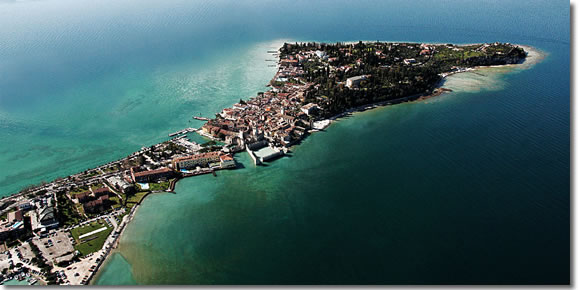
If you look closely at a map of Lake Garda, from the very middle of the flat, southern end of the lake springs a long, skinny peninsula, rarely more than a few hundreds yards wide, jutting about two miles into the lake.
At this tip of this spit of land sits Sirmione, the loveliest town on Lake Garda.
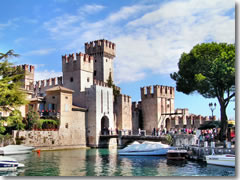
The Scaglier Castle. (Photo by yilmaz ovunc.)I love driving to Sirmione because you literally have to have a guard let you over the drawbridge, across the moat and, and under the portcullis of the remarkably intact castle walls in order to get into town.
(Not that I advise driving through town. There's basically one street, crammed with pedestrians, so you inch along much more slowly than if you were walking, squeezing the other tourists up against the walls and getting very dirty looks for about 20 minutes. Still, it's cool to be stopped at the castle gate by a guard—even if you're just in a rented Fiat rather than atop a white stallion.)
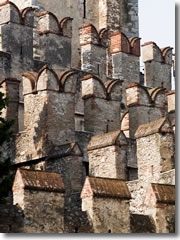
Merlins on the Castello Scagliero. (Photo by RoCam) The Scaglieri clan of Verona placed this 13th century keep at the narrowest point of Sirmione's long peninsula, and effectively created an island of the end of it by dredging out a moat from one side to the other. The stone citadel was in use as a fortress until the 19th century.
Though the interior is almost barren, the climb up the 93-foot tower is worth it for the panorama.
The Castello Scagliero is at Piazza Castello 1, Sirmione (tel. +39- 030-916-468).
It's open Tuesday to Sunday from 8:30am to 7:30pm (October to March, it closes at 4:30pm).
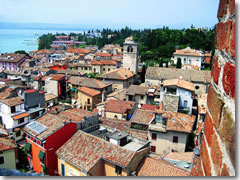
The town of Sirmione. (Photo by Keksylein)Once you're past the castle, you'll find Sirmione is a popular resort town, with plenty of hotels, piazzas open to the sea, shopping, and gelato parlors, but also some fine little churches like the 8th century San Pietro in Mavino with its medieval frescoes.
The town's real show-stopper, though, is the ruined complex of a Roman villa at the promontory's very tip called the Grotte di Catullo.
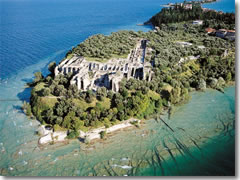
The villa at Grotte di Catullo, Sirmione. (Photo courtesy of Brescia Tourism). This villa—park of a lovely, park-like archeological complex extending over five acres—is the second-best surviving example of a Roman private home in all of northern Italy.
It is not, however, a grotto, nor did it ever belong to Catullus.
The ancient Roman poet Catullus, whose family was from Verona, did, indeed, take his holidays at Sirmione. However, there is zero evidence that this vast ancient complex was actually his villa.
In fact, it was probably built after his death, sometime in the 1st century BC atop a series of underwater caves containing some of the natural hot springs that well up in spots all over the waters of Garda.
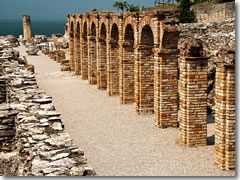
Ruins at Le Grotte di Catullo. (Photo by David Blaikie) The town simply decided to name its most famous Roman ruins after its most famous ancient Roman resident.
It was misnamed a "grotto" because, in later centuries, the romantically overgrown ruins, covered in an olive grove twittering with birdsong, seemed to be a network of underground caves.
You can visit these surviving passageways, some retaining decorative stuccoes, only on guided tours.
The Grotte di Catullo is located on the tip of the Sirmione peninsula at Piazzale Orti Manara 4 (tel. +39-030-916-157, www.archeologica.lombardia.beniculturali.it).
Its open hours are slightly complicated, but basically:
Sirmione tourist office
Viale Marconi 2 (in the parking area just before the bridge into the old center)
tel. +39-030-916-114 or +39-030-916-245
www.bresciatourism.it
www.gardariviera.com
If you'd prefer to take a guided day trip from Milan to visit Sirmione (and nearby Desenzano and Verona), consider booking one through our partners at Viator.com:
The Sirmione tourist information office is in a kiosk on your left when you arrive at the far end of the parking area, just before the bridge into the old center, at Viale Marconi 2 (tel. +39-030-916-114 or +39-030-916-245; www.bresciatourism.it and www.gardariviera.com).
Luckily, Desenzano del Garda, at the southwestern corner of the lake, is a stop on the main Venice–Milan train line. From the Desenzano train station, buses (www.trasportibrescia.it) leave once or twice an hour hour for the 20– to 30-minute ride to Sirmione.
How to get to Sirmione from Verona: There are also hourly buses from Verona to Sirmione (70 min.; www.trasportibrescia.it).
If you don't take a tour or have a rental car (recommended), the easiest way is by bus (www.trasportibrescia.it) or by boat (www.navigazionelaghi.it).
Share this page
Search ReidsItaly.com
Sirmione tourist office
Viale Marconi 2 (in the parking area just before the bridge into the old center)
tel. +39-030-916-114 or +39-030-916-245
www.bresciatourism.it and www.gardariviera.com